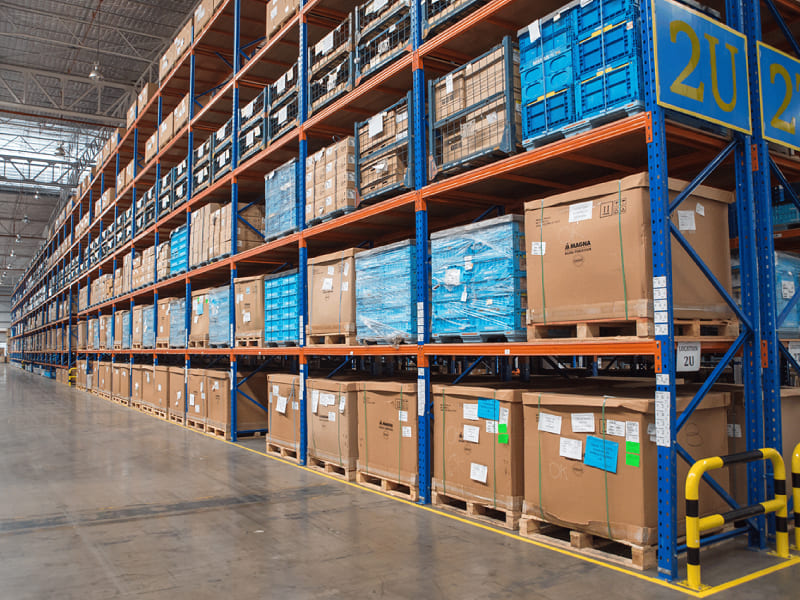A raw material warehouse is a kind of facility storing the basic material for the next manufacturing period. In the industrial context,
The raw material can be metals, wood, plastics, chemicals, or even hazardous materials. Disciplined coordination with the distribution center should be beneficial for the plant owner.
To maintain the traceability of inventory loads, Raw material warehouses are usually equipped with a WMS Warehouse Management System; To ensure a constant supply of raw materials, the design purpose should involve minimal operations and quick access.
To facilitate the workflow of the manufacturing process, the raw material warehouse should be easily available for both suppliers and production plants to reduce incurring costs and operational time.
To ensure the quality and physical nature of certain raw materials, such as agricultural and in vivo medical products, which are sensitive to fluctuation of environmental change. In a case like that it’s essential to guarantee adequate cooling conditions at all times.

Selective racking is the most common type of pallet racking system used in warehouses. It provides direct access to every pallet, making it ideal for warehouses that require frequent picking. This system is highly versatile and can accommodate various pallet sizes, but it typically offers lower storage density compared to other systems.
Drive-in racking is designed for high-density storage and is ideal for homogeneous products. This system allows forklifts to enter the racking structure to load and unload pallets. While it maximizes storage space, it provides limited access, making it suitable for materials that are not frequently accessed.
Push-back racking systems allow for multiple pallets to be stored on a single lane, with each lane capable of holding up to six pallets deep. Pallets are loaded from the front and move back along inclined rails. This system offers high storage density and better access compared to drive-in racking but comes at a higher cost.
Pallet flow racking, also known as gravity flow racking, uses a first-in, first-out (FIFO) system. Pallets are loaded at the higher end and move to the lower end on rollers. This system is excellent for materials with expiration dates and ensures efficient stock rotation. However, it requires precise setup and maintenance to function correctly.
When selecting a pallet racking system, one must consider the storage capacity and density. Drive-in and push-back racking systems offer higher density storage, which is beneficial for warehouses with limited space. Conversely, selective racking provides lower density but higher accessibility.
Accessibility and retrieval speed are crucial in raw material warehouses where timely access to materials is necessary. Selective racking excels in this area by allowing direct access to each pallet. In contrast, drive-in racking may slow down retrieval times due to its deeper storage lanes.
Cost is a significant factor in choosing a pallet racking system. While selective racking is generally more affordable, drive-in and push-back systems require a higher initial investment but can save space and potentially reduce long-term costs by optimizing storage capacity.
Safety and compliance are paramount in raw material warehouses. All racking systems must adhere to safety standards to prevent accidents. Pallet flow and push-back racking systems often include safety features such as brakes and guards, which help in maintaining a safe working environment.

The first step in choosing the right pallet racking system is assessing the specific needs of the warehouse. Factors such as the type of raw materials stored, the frequency of access, and the available space will guide the decision.
Once the warehouse needs are assessed, the next step is to match these needs with the features of available pallet racking systems. For example, a warehouse with high turnover rates might benefit more from selective or pallet flow racking systems due to their accessibility and efficient stock rotation.
Consider looking at case studies or examples from similar industries. For instance, a food production facility may choose pallet flow racking to ensure FIFO stock rotation, while an automotive parts warehouse might opt for drive-in racking to maximize storage density for large, homogeneous items.
Proper installation is crucial for the effectiveness and safety of pallet racking systems. It is recommended to follow manufacturer guidelines and use professional installation services to ensure the racking system is correctly assembled and secured.
Regular maintenance and inspection routines are essential to ensure the longevity and safety of pallet racking systems. This includes checking for damages, ensuring all components are secure, and adhering to load limits.
Training staff on the proper use of pallet racking systems and implementing safety protocols can prevent accidents and damage to the racking. Employees should be aware of load limits, correct loading and unloading procedures, and emergency protocols.
For the industrial expert in vison racking, we prioritize the safe storage of raw materials. If you need advice or would like to send an inquiry on industrial warehouse racking, we will reach out to you with the best storage solution
Selective racking offers high accessibility and flexibility, allowing for easy picking of individual pallets. It is ideal for warehouses with a diverse range of materials and high turnover rates.
Drive-in racking optimizes space by allowing high-density storage. Forklifts can enter the racking structure to load and unload pallets, making it suitable for storing large quantities of homogeneous products.
Pushback racking generally has a lower initial cost compared to pallet flow racking. However, pallet flow racking offers better stock rotation and can reduce costs related to product obsolescence.
Safety in a raw material warehouse can be ensured by regular inspections, adhering to load limits, proper staff training, and implementing safety features such as guards and brakes in racking systems.
Key factors in maintaining pallet racking systems include regular inspections, immediate repair of damages, adherence to load limits, and proper training for staff on correct usage and safety protocols.
Copyright © 2026 Smartpalletglobal All Rights Reserved.  Network Supported
Network Supported
Sitemap | Blog | Xml | Privacy Policy